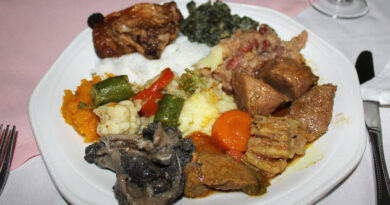Tomato bredie
Tomato Bredie: A South African Culinary Masterpiece
Introduction:
In the colorful mosaic of South African cuisine, where flavors dance with diversity, one dish holds a special place in the hearts of many—Tomato Bredie. This hearty stew, rich in tradition and bursting with robust flavors, has woven itself into the fabric of South African culinary heritage. Join us on a delectable journey as we explore the origins, ingredients, preparation methods, and cultural significance of Tomato Bredie, celebrating the soulful symphony that makes it a culinary masterpiece.
Origins and Cultural Significance: A Tapestry of South African Heritage
Historical Roots:
Tomato Bredie traces its roots to the Cape Malay community, an ethnic group with a unique culinary heritage that has significantly influenced South African cuisine. The word “bredie” itself has its origins in the Dutch language, referring to a type of stew.
Culinary Fusion:
Cape Malay cuisine is a beautiful fusion of flavors influenced by Indonesian, Dutch, and African culinary traditions. Tomato Bredie, with its aromatic spices and savory richness, reflects this harmonious blend, showcasing the diversity that defines South African food culture.
Ingredients: The Symphony of Flavors in Tomato Bredie
Main Ingredients:
- Tomatoes: At the heart of Tomato Bredie is the vibrant redness of ripe tomatoes. This key ingredient imparts a sweet and tangy base to the stew.
- Lamb or Mutton: Traditionally, Tomato Bredie is made with lamb or mutton, contributing succulence and depth to the dish.
- Onions and Garlic: Aromatic onions and garlic form the savory foundation, adding layers of flavor to the stew.
- Spices: The magic of Tomato Bredie lies in its spice blend, featuring cinnamon, cloves, cardamom, and other warm, aromatic spices that infuse the stew with complexity and warmth.
- Potatoes: Potatoes are often added to Tomato Bredie, contributing a hearty and comforting element to the dish.
Optional Additions:
- Chilies: For those who enjoy a bit of heat, chilies can be added to provide a spicy kick to the stew.
- Carrots: Some variations of Tomato Bredie include carrots, introducing a subtle sweetness and enhancing the visual appeal with vibrant colors.
Preparation Method: Crafting the Culinary Symphony
Slow-Cooked Perfection:
- Browning the Meat: The lamb or mutton is often browned in a pot, creating a rich flavor base through caramelization.
- Sautéing Onions and Garlic: Aromatics like onions and garlic are sautéed until golden, infusing the stew with savory goodness.
- Adding Spices: The spice blend, including cinnamon, cloves, and cardamom, is added to the pot, filling the kitchen with a warm, inviting aroma.
- Incorporating Tomatoes: Ripe tomatoes are introduced, their juices melding with the spices to create the flavorful essence of Tomato Bredie.
- Simmering to Perfection: The stew is left to simmer, allowing the ingredients to marry and develop a depth of flavor. This slow-cooking process is a hallmark of Tomato Bredie.
- Adding Potatoes and Optional Ingredients: Potatoes (and any optional ingredients) are added later in the cooking process, ensuring they are perfectly tender by the time the stew is ready to be served.
Cultural Traditions: Tomato Bredie as a Culinary Heritage
Family Gatherings:
Tomato Bredie often takes center stage during family gatherings, especially on Sundays, when families come together to share a comforting meal. The aroma of the stew wafting through the air is a familiar and cherished part of these gatherings.
Cultural Celebrations:
Whether it’s a festive occasion or a special family celebration, Tomato Bredie is a dish that symbolizes abundance and togetherness. Its presence on the dining table adds a touch of tradition to the festivities.
Passing Down Recipes:
The art of making Tomato Bredie is often passed down through generations, creating a sense of continuity and connection to South African roots. Grandmothers, mothers, and aunts share their recipes and cooking techniques, ensuring that the legacy of Tomato Bredie lives on.
Variations and Adaptations: Tomato Bredie Across South Africa
Regional Influences:
South Africa’s diverse regions contribute their unique twists to Tomato Bredie. In the Western Cape, where Cape Malay influences are strong, the stew may include more spices and aromatic flavors. In other regions, local preferences and ingredient availability shape the dish.
Vegetarian Options:
For those seeking a meatless alternative, Tomato Bredie can be adapted to include vegetables like butternut squash, sweet potatoes, or chickpeas, maintaining the stew’s rich flavors and heartiness.
Modern Interpretations: Tomato Bredie in Contemporary Cuisine
Fusion Cuisine:
In modern South African kitchens and restaurants, chefs are exploring creative fusions of Tomato Bredie. Whether served over couscous, paired with international ingredients, or reimagined in a tapas-style dish, Tomato Bredie continues to evolve while staying true to its roots.
Culinary Innovation:
Tomato Bredie has become an inspiration for culinary innovation, with chefs experimenting with different proteins, spices, and textures to create new and exciting variations of this classic dish.
Conclusion: Tomato Bredie – A South African Culinary Emblem
Tomato Bredie is more than just a stew; it is a cultural emblem that encapsulates the warmth, richness, and diversity of South African cuisine. Its ability to bring families together, evoke a sense of tradition, and showcase the fusion of culinary influences makes it a beloved dish that resonates with both heart and palate.
As we savor the flavors of Tomato Bredie, we partake in a culinary journey through South African history, culture, and the kitchens of generations past. Whether enjoyed in a cozy family setting or embraced in contemporary culinary expressions, Tomato Bredie stands as a testament to the enduring legacy of South African gastronomy—a masterpiece that continues to bring joy, comfort, and a taste of tradition to tables around the world.



